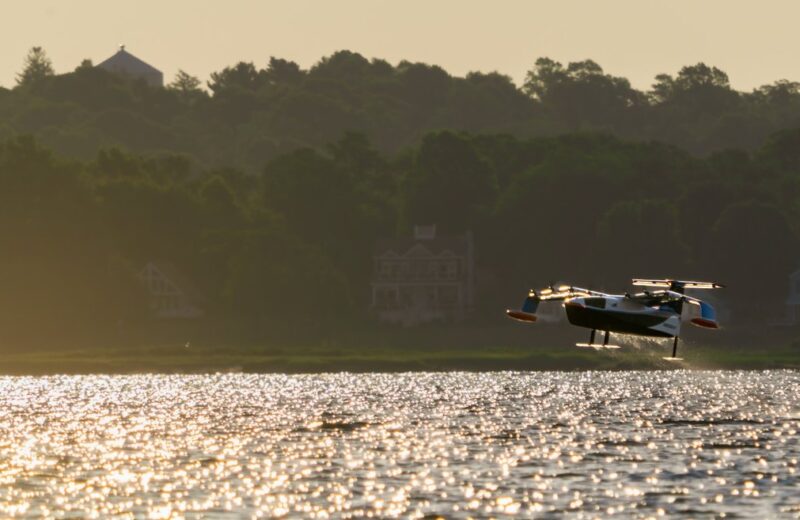Revolution.Aero: REGENT Craft’s ground e-ffect

Ground effect vehicles, which fly within a wingspan of a surface, are nothing new. The Soviet Union’s Ekranoplan – aka the Caspian Sea Monster – is probably the most famous and that was designed in 1975. But the history of ground effect craft goes back further, as much as 60 years. Now, as electric regional air mobility (eRAM) evolves, there is a company making new waves, quite literally, in the space.
Founded in 2020, Massachusetts-based REGENT (short for Regional Electric Ground Effect Nautical Transport) Craft has gone from “a drawing on a napkin” to its first successful flight in 15 months. The company under its “float, foil, fly” motto has created a new definition in the eRAM space – sustainable maritime mobility.
The firm has accumulated a backlog of up to $7bn in orders from ferry and aircraft operators as it aims to enter commercial service during 2025. Ambitious timeframes for operational service have almost become synonymous with AAM – 2026 is often touted as kick-off, so what makes REGENT confident about 2025?
The answer lies, in large part, in REGENT’s maritime certification process. Anything that flies within a wingspan of the water’s surface is classified, by most jurisdictions, as a boat. So instead of dealing with the FAA or EASA, alongside a long list of other start-ups and developers, REGENT’s certification is based on the International Maritime Organisation’s (IMO) Type A ‘wing-in-ground’ (WIG) definition and will be overseen by the US Coast Guard (USCG). The firm’s all-electric seagliders – its quarter-size prototype, Squire, 12-seat Viceroy and 50-100 seat Monarch – are all classified as WIG craft.
The question REGENT’s founders asked was how can advanced and regional air mobility be approached differently?
“So, they decided to dust off WIGs which have been around for decades,” Tim Rhatigan, REGENT’s director of Government Business Development, tells Revolution.Aero. “WIGs have traditionally been confined aerodynamically to that very strict flight regime where you are travelling quite literally skimming the surface of the water. What we have been able to do, that no one else has done, is incorporate the intermediary step of a high performance, fully-actuated, hydrofoil system.”
The firm has now patented this hydrofoil system. Rhatigan says it is this, in large part, that unlocks the commercial viability of WIGs. But moving anything by air, especially people, requires optimum safety. It should be the primary focus of any OEM designing a new aircraft.
“If you think about passenger comfort and safety in our sector – both in the ferry and coastal point-to-point airline market – you can literally board at the dock on the hull, at a very low airspeed come up on foils so you are highly manoeuvrable and then, when you are in open water, harness the ground effect to essentially become an airplane,” Rhatigan explains.
Although REGENT received an approval in principle (AiP) for its WIG from maritime classification society, Bureau Veritas Marine & Offshore, the firm is also undertaking a parallel certification process with the US Coast Guard (USCG). In the US, the coast guard can regulate WIG vehicles under its statutory authority to regulate small passenger vessels. REGENT is working with the USCG on its Design Basis Agreement, which is roughly analogous to a G1 or G2 under FAA certification.
“That approval will map out what our certification process will look like over the next two years. We are tracking toward a full-scale prototype in Q1 of 2024 and a commercial vehicle by the end of 2025 – that’s Viceroy,” he says.
Historically, WIGs have been very difficult to fly, pilots require extreme focus to keep the aircraft in ground effect. As a former Navy helicopter pilot, Rhatigan understands all too well the difficulties in flying close to water at high speed. “So we’ve wrapped the entire vehicle in a highly automated, digital flight control system. The glider is automated to the point where a maritime captain as opposed to an aircraft pilot will be operating the vehicle.”
This means in the US a ferry operator will be able to complete an eight to 10 week training course to attain certification as a seaglider operator.
By completing each stage of the certification process to levels required for traditional aircraft certification, REGENT is thinking ahead five to 10 years from now. Whilst ensuring safety, it allows REGENT to transition efficiently into electric aircraft production should it decide. For now though we will be remaining in ground e-ffect.






